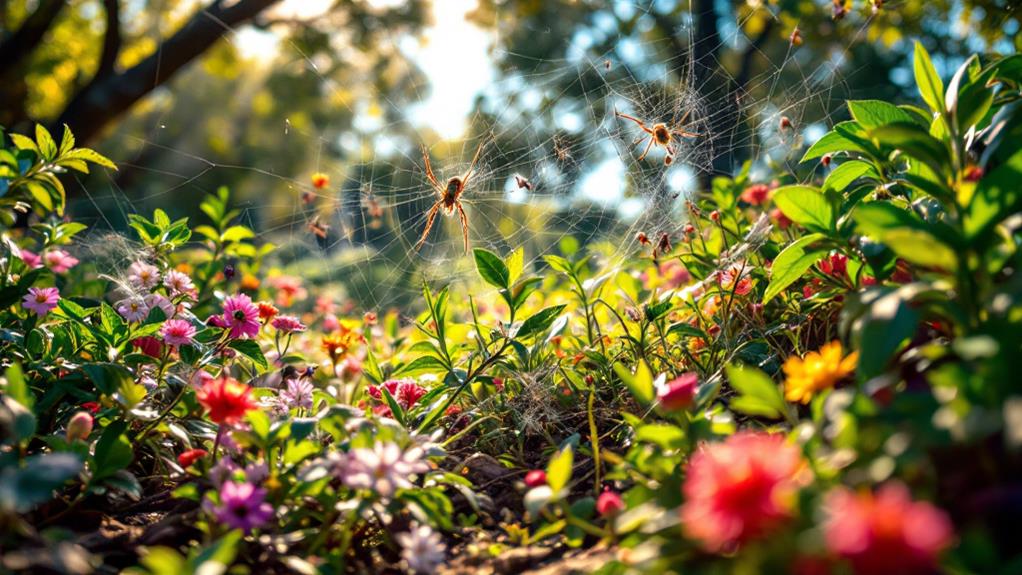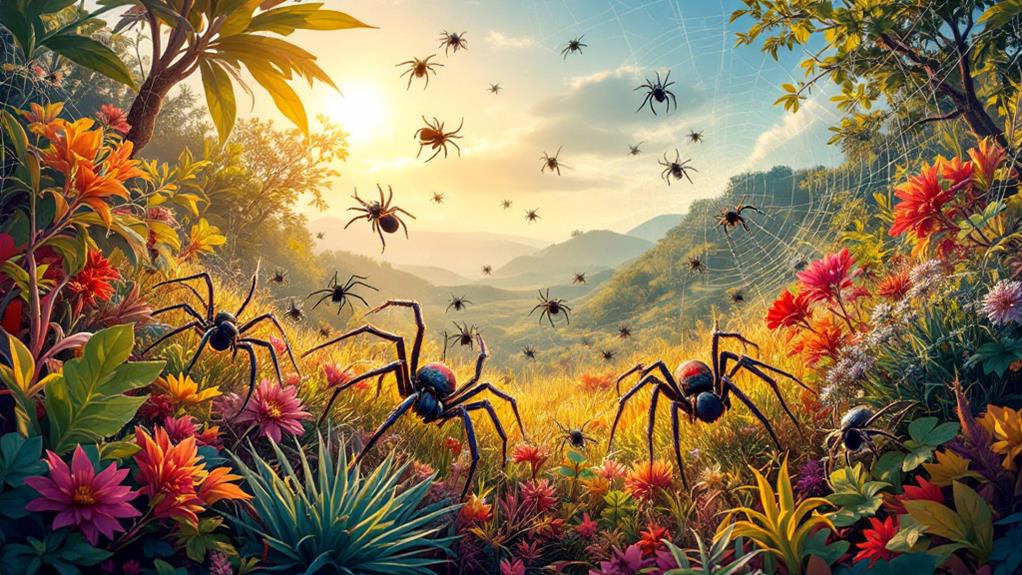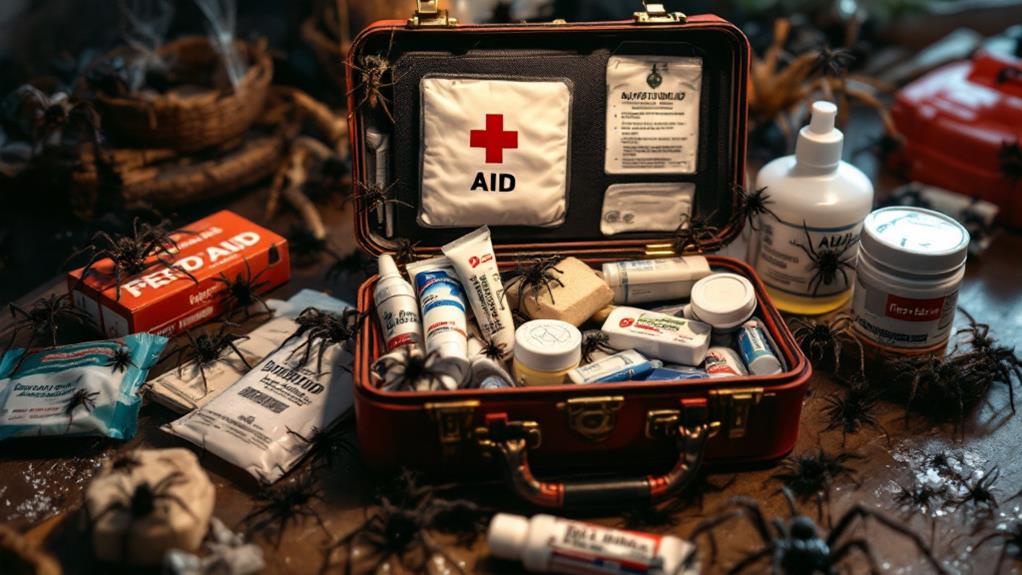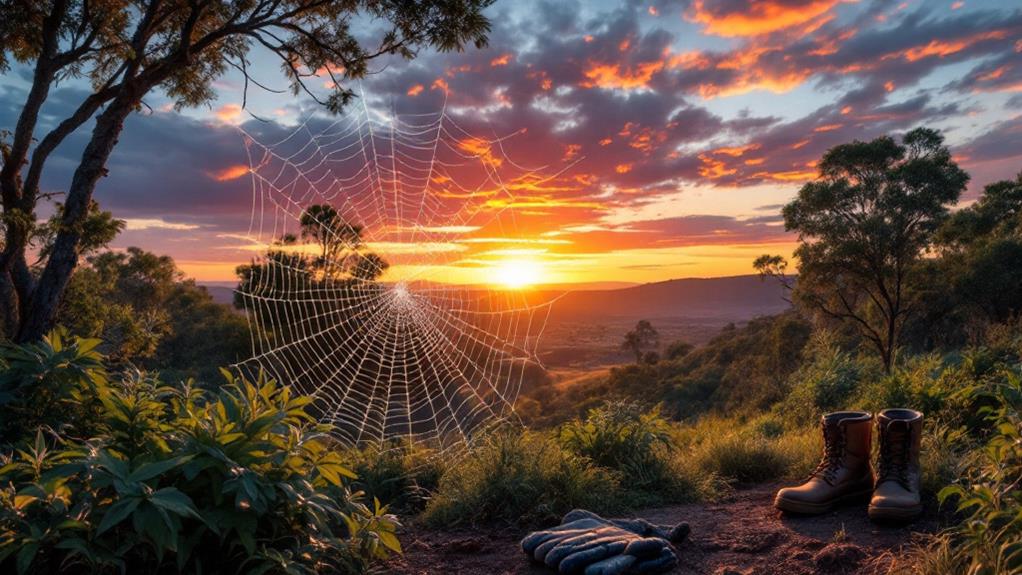When Is Spider Season in Australia? What You Need to Know

Spider season in Australia starts in late summer and goes through autumn. Expect to see more spiders as the rainfall increases and temperatures rise, creating perfect conditions for their activity and reproduction. During this time, spiders, including the more notorious ones like redbacks and funnel-webs, become more visible. While some species can pose a threat, most are harmless and actually help control pests. Don't let myths scare you—understanding and identifying local spiders can change perceptions. Curious about what else you should know about spider season? There's plenty more to uncover about these fascinating creatures.
Timing of Spider Season
As the seasons shift from late summer to fall in Australia, you'll notice the onset of spider season, marked by increased rainfall and warmer temperatures. This period typically begins with the shift to autumn, when conditions become ideal for spider activity. In places like Sydney, the average rainfall during autumn exceeds five inches per month, creating perfect conditions for spiders to thrive. The combination of moisture and warmth encourages spider reproduction, leading to a surge in their numbers.
While spiders are present all year, during spider season, they're more visible and active. The warmer months, especially spring and summer, see them out and about, but it's the autumn rains that really kickstart their season. You'll find them weaving intricate webs and exploring new territories, thanks to the favorable weather patterns.
However, the timing of spider season can vary across different regions in Australia. It generally aligns with local weather conditions that promote spider reproduction and migration. So, if you're planning to be in Australia during these months, be prepared for an increase in spider sightings. Welcome the natural wonder of spider season, and remember, they're more beneficial than bothersome.
Spider Ballooning Phenomenon
While autumn rains mark the peak of spider season, they also set the stage for the fascinating spider ballooning phenomenon. During this time, flooding events prompt sheet-web weavers to release silk threads, which act as a mode of escape to higher ground. As these tiny arachnids take to the skies, millions of them can create an awe-inspiring spectacle, weaving spider webs that stretch over trees, poles, and grasses for miles. This phenomenon can resemble a surreal snowfall effect, transforming entire landscapes in the blink of an eye.
In New South Wales, where this event is most commonly observed, autumn rains are a catalyst for spider ballooning. Sydney, for instance, averages over five inches of rain monthly during this season, triggering the mass migration. The silk strands, acting like parachutes, allow spiders to travel significant distances through the air, sometimes moving in colonies.
Though this might sound unique to Australia, similar events have been observed globally, including places like Texas and Greece. There, too, environmental conditions have led to extensive web formations, showing that this natural marvel isn't confined to one corner of the world. Keep an eye out, and you might just witness it yourself!
Notable Spider Species

Australia's diverse landscape is a haven for over 2,500 spider species, each with unique characteristics and behaviors. Among the most notable spiders in Australia are the redback and funnel-web spiders. The redback spider, easily recognized by its black body and striking red or orange marking on its abdomen, often conceals itself in dark, sheltered spots like letterboxes and outdoor furniture. Although they pose a threat to humans, encounters can usually be avoided by taking simple precautions.
The funnel-web spider, on the other hand, is famous for its aggressive behavior when disturbed. Considered one of the most dangerous spiders globally, its bite can be fatal if left untreated. However, prompt medical attention can effectively mitigate the risk.
Not all spiders in Australia are harmful. Take the huntsman spider, for example. These large, fast arachnids might look intimidating, but they're generally non-aggressive and quite beneficial as they help control pests in homes and gardens.
Then there's the white-tailed spider, known for its grey to black body and distinctive white tip on its abdomen. After wet weather, they often surface, and while their bites can cause irritation, they're typically not serious.
Public Perception and Safety
Many people in Australia fear spiders, but the reality is most of these creatures are harmless to humans. Of the over 2,500 spider species in Australia, only a few, like the redback and funnel-web spiders, pose any significant danger. Most spiders prefer to steer clear of human interaction, making encounters less likely than you might think.
Public perception of spiders often leans towards fear, yet understanding their ecological benefits can help shift this view. Spiders play an essential role in controlling insect populations, which helps maintain biodiversity. Local officials advocate for appreciating communal spider nests, as they support a healthy ecosystem. With increased awareness, you can learn to coexist with these fascinating creatures rather than fear them.
Public interest in spiders is evident, with curious visitors and entomologists drawn to areas where large webs are found. This fascination presents an opportunity to educate yourself about different local spider species and their behaviors. By learning to identify them, you can reduce unnecessary fears and appreciate the unique role they play in nature. Embracing this knowledge can transform your perception of spiders from one of fear to understanding and respect.
First Aid for Spider Bites

Encountering a spider bite can be alarming, but knowing the right primary aid steps can help you manage the situation effectively. Initially, it's vital to seek medical attention immediately following a spider bite to guarantee proper treatment and management of symptoms. While waiting for help, there are some significant steps you can take to minimize potential complications.
- Clean the bite area: Use soap and water right away to reduce the risk of infection.
- Apply a pressure bandage: For funnel-web spider bites, this slows the spread of venom. Remain still until help arrives.
- Use ice: For redback spider bites, apply ice to the bite site, but avoid compression.
In addition to these measures, keep the affected limb immobilized to prevent further spread of venom. Position it at or below heart level to reduce circulation speed. Throughout this process, closely monitor for signs of an allergic reaction or infection, such as increased swelling, redness, or difficulty breathing. Staying calm and following these steps can greatly assist in managing a spider bite before professional medical help arrives, promoting the best possible outcome for your health.
Myths About Australian Spiders
Despite their reputation, Australian spiders aren't the deadly creatures they're often made out to be. A common myth suggests that all spiders in Australia are lethal. However, of the over 2,500 different species, most pose no threat to humans and actually play essential roles in the ecosystem, like controlling insect populations. You might also hear that these spiders are aggressive, but that's not true either. Generally, they prefer to avoid humans and will only bite if they feel cornered or threatened.
Another myth is that climate change is causing a spike in spider populations. While it's a compelling story, research hasn't confirmed any trend of increasing numbers. So, before you start worrying about swarms of spiders taking over, know that the evidence just isn't there.
You might also be surprised to learn how rare spider bites are. The initial recorded death from a spider bite in Australia since 1981 happened only in 2016. And regarding children, not all spiders are a danger. Educating yourself and your family on identifying local species can help dispel fears, as most bites are due to defensive reactions rather than unprovoked attacks.
Safety Tips for Travelers

When you're traveling in Australia, especially during spider season, it's vital to be cautious and informed to secure a safe and enjoyable trip. Many spiders, with their long legs, reside in dark or hidden spaces, so avoid reaching into these areas to prevent startling them. Defensive bites often occur when spiders feel threatened, making it critical to be vigilant.
Before putting on shoes, wetsuits, or clothes, give them a good shake to verify no eight-legged hitchhikers are hiding inside. This is particularly significant in regions known for spider activity. When you're exploring bushland or rural areas, wear closed shoes and long pants to minimize the risk of bites. This simple precaution can save you from unexpected encounters with spiders lurking in natural settings.
Remember to check your bedding, especially if it's on or near the floor. This practice helps avoid surprises when you're settling in for the night. To further improve your safety:
- Educate yourself on identifying local spider species and their habitats.
- Be aware of your surroundings in spider-prone areas.
- Stay calm and avoid panicking if you encounter a spider.
These measures will secure a safer and more enjoyable expedition.
Ecological Role of Spiders
Spiders frequently play an essential role in our ecosystems by controlling pest populations and aiding in the balance of nature. With over 2,500 species identified in Australia, spiders are significant contributors to biodiversity and the health of natural environments. By preying on numerous insects, they help maintain balanced ecosystems, preventing any single species from becoming too dominant. This natural pest control reduces the need for chemical pesticides, making your environment healthier.
During certain events, like flooding, you'll notice mass spider migrations. These movements can impact local ecosystems by redistributing spider populations and increasing their predatory pressure on insect communities. This shift can actually be beneficial as it helps regulate insect numbers in new areas, preventing potential outbreaks.
The webs that spiders create are not just for capturing prey. They also offer habitat and shelter to other species, adding complexity to food webs. These intricate structures support a variety of life forms, fostering a rich ecological tapestry. Understanding these benefits can help you appreciate spiders' roles and encourage coexistence within human environments. By recognizing their ecological importance, you're more likely to value their presence and support balanced ecosystems.




